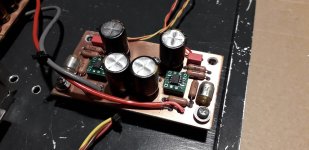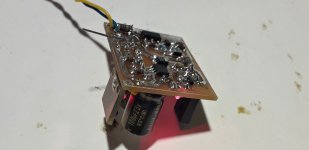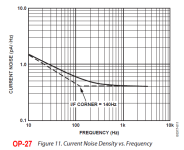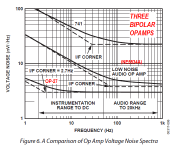Some further testing shows the ADA4625 tolerates 500R loads gracefully too...
[ Actually that graph contradicts figure 83 (PSRR against temperature) ]
[[ also I note the single version has lower distortion specs, although my measurements are of a dual version and seem perfectly fine ]]
That does seem to be its only weakness, requiring more careful supply decoupling/filtering/regulation.Datasheet Figure 31 of ADA4625-2 is a little disconcerting. PSRR vs frequency
[ Actually that graph contradicts figure 83 (PSRR against temperature) ]
[[ also I note the single version has lower distortion specs, although my measurements are of a dual version and seem perfectly fine ]]
Last edited:
I nabbed a few at my local surplus emporium, TI flavor. I intend to try the trick where you disable the input stage and replace it with a jfet diff amp, as outlined in the Siliconix jfet data book. I'll probably end up using the 2SK117 for that purpose.
Here's the Siliconix app note that discusses replacing the front end of an NE5534 with a cascoded jfet differential stage. I'll likely be using the 2SK117, cascoded with a pair of PN4391 jfets.
https://www.waynekirkwood.com/image...gh_Performance_Siliconix_AN81-3_July_1983.pdf
https://www.waynekirkwood.com/image...gh_Performance_Siliconix_AN81-3_July_1983.pdf
Datasheet Figure 31 of ADA4625-2 is a little disconcerting. PSRR vs frequency
Various graphs suggest AD's AC measurement rig tops out at 110dB or even less whereas the DC rig allows for 130dB and beyond.That [PSRR] does seem to be its only weakness, requiring more careful supply decoupling/filtering/regulation.
[ Actually that graph contradicts figure 83 (PSRR against temperature) ]
[[ also I note the single version has lower distortion specs, although my measurements are of a dual version and seem perfectly fine ]]
PSRR AC graphs look definitely noise-limited to me. And they are for the slightly worse dual I would assume because -PSRR matches the Aol for the dual (eg @10kHz). The 10dB Aol difference at audio frequencies between the single and the dual is quite unusual.
I wonder if graph 31 shows a failure of the test fixture though? As I some some versions of the datasheet show a graph of PSRR against temperature that doesn't match, and looking at other similar devices the PSSR rises much more with decreasing frequency at 36V than at 5V...
I suppose I should figure out a way to measure this.
Yes I noticed the difference between single and dual - this isn't unexpected as they will have used more die per area device for the single one, and can select for performance more economically (with a dual device you have to reject if either channel is below par)
I suppose I should figure out a way to measure this.
Yes I noticed the difference between single and dual - this isn't unexpected as they will have used more die per area device for the single one, and can select for performance more economically (with a dual device you have to reject if either channel is below par)
Last year I tested the ADA4625-1 as an IV stage and I must admit that I was delighted with the sound, it's just a little worse than the AD811, which I consider the best for that purpose.
I also use it in Walt Jung's regulators (tested from 5V to 18V, + and -) and consider it the best op amp for that purpose, however, without good decoupling, self-oscillations can appear. Otherwise with other op amps such a decoupling is not necessary but only with the ADA4625-1 so I would agree with both Marks regarding the decoupling.
I also use it in Walt Jung's regulators (tested from 5V to 18V, + and -) and consider it the best op amp for that purpose, however, without good decoupling, self-oscillations can appear. Otherwise with other op amps such a decoupling is not necessary but only with the ADA4625-1 so I would agree with both Marks regarding the decoupling.
Attachments
Something smells fishy here for sure, datasheet still is Rev.A, so it could well be some mistakes are still in there.I wonder if graph 31 shows a failure of the test fixture though? As I some some versions of the datasheet show a graph of PSRR against temperature that doesn't match, and looking at other similar devices the PSSR rises much more with decreasing frequency at 36V than at 5V...
I'm inclined to trust the DC values and extrapolate PSRR and CMRR from that.
At 5V supply, it looks like the 5V bootstrap for the first and second stages already has run out of headroom which might actually degrade PSRR and CMRR. At +-18V it should fully isolate those stages from V+ which should make PSRR+ textbook excellent. At least nothing seems to indicate the contrary.
The OPA1677 could be a good replacement for the NE5534A. I think that TI used to market the OPA167x as a successor to the NE5532.
The voltage noise density curve is not so good as the one of the NE5534A but if you use it with low gain settings it performs well.
The voltage noise density curve is not so good as the one of the NE5534A but if you use it with low gain settings it performs well.
The NE5534 hit the street about when I was starting my first real job out of school around 1977 - I vaguely remember the product announcement.
Good spot, and the OPA1677/1678 are considerably cheaper than the ADA6425-1/-2The OPA1677 could be a good replacement for the NE5534A. I think that TI used to market the OPA167x as a successor to the NE5532.
The voltage noise density curve is not so good as the one of the NE5534A but if you use it with low gain settings it performs well.
The CMOS opamps all have stirling performance except for 1/f noise which is very high IMV although Marcel has said he doesnt think it’s an issue. Scott Wurcer remarked on this site a few years ago that he had to push for low(er) 1/f noise when opamps were being spec’d at ADI.
I have settled on the JFET OPA1642 for general low level signal work and the OPA1612 for bip inputs. The OPA1612 makes a very credible MC head amp for 500uV level signals.

I have settled on the JFET OPA1642 for general low level signal work and the OPA1612 for bip inputs. The OPA1612 makes a very credible MC head amp for 500uV level signals.
One way to reduce 1/f noise in a CMOS opamp is to increase the gate length and also the gate area of the devices in the input stage. Increasing L gets you away from the short channel effects, but you then need to increase W to get a decent gm. Increasing A decreases 1/f noise. The only trouble with that approach is that the input stage devices become enormous, thus, more capacitive and more expensive. Basically, you end up having to trade off cost and bandwidth to get lower 1/f noise. Opamps tend to be cheap so the bean counters often win that battle.
Tom
Tom
Engineering is always about trade offs! I guess low noise audio isn’t on everyone’s radar and there are good alternatives in TI’s portfolio for that if needed. CMOS opamps are great for filters, line stages, headphone amps etc.
Alas the OP27 has bias current cancellation circuitry, so when the inputs see difference impedances (as in most low noise preamp situations), the actual current noise is higher than those curves suggest. With equal impedances the cancellation circuit noise cancels out, otherwise it adds to the noise signature and makes the device noisier than a NE5534A - basically the benefit of low bias current comes at the expense of more noise in practical circuits. Sometimes datasheets admit this, often its ignored.
I made the mistake to trying to use an LT1115 (I believe it has bias current cancellation) in a phono preamp with a cartridge that has nearly a Henry of inductance (Stanton 680, sadly no more now that Stanton has imploded) - hissed like a nest of snakes... Scott Wurcer fixed me up with some AD745JN samples, and that de-hissed it. That same preamp is still doing yeoman duty in our radio station main production studio, going on 20 years now.
It certainly has bias current compensation, like the quite similar LT1028 and LT1128. Linear Technology managed to design and specify it such that the actual input noise current is as much as some 10 dB above the differential noise current, see https://audioxpress.com/article/boo...spice-models-to-simulate-vintage-op-amp-noise
- Home
- Source & Line
- Analog Line Level
- NE5534A end of life announced



